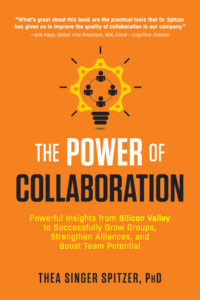Boost Your Team‘s Potential
If you want to create amazing results, you must almost always learn the power of collaboration. In a world that seems more polarized than ever, achieving true collaboration may seem more difficult than ever.
Dr. Thea Singer Spitzer is the founder of Critical Change, LLC, and she believes that we need a new approach. A consultant, strategic advisor, and coach to top executives for nearly 30 years, she has researched and experienced these issues first hand.
Her new book, The Power of Collaboration, is a guidebook to effective teamwork. I recently spoke with her about her new book and her unique perspective on collaboration.
The Power of Collaboration is the title of your new book. Tell us about that power and why tapping it is vitally important.
The Power of Collaboration is reaching an entirely different level of achievement by working exceptionally well with others. When we do this, we alter the climate and create radically better outcomes rather than trying to convince others that ‘our way is the right way’ or working around those others if we are unable to convince them.
When we are really collaborating, we create what Michael Schrage calls, a ‘communal brain.’ We not only bring out everyone’s best, we’re able to turn those ideas into a ‘collective intelligence,’ which allows us to achieve better results.
Turning individual perspectives into collective intelligence isn’t a new concept. Most companies are much better at it than they were 10 or 15 years ago. But those improvements may be making us lackadaisical. We’re so busy patting ourselves on our backs for the distance we’ve come, we’re not realistically assessing where we are still falling short. The idea of collaborating sounds simple because of the progress we’ve made. But in a world where people with opposing views on nearly every topic imaginable must come together to achieve organizational objectives, it’s not as easy as it sounds.
Employees and teams may be quite capable of handling their specific areas of focus. But unless they work together in a whole different way, products, services, and profits will suffer. Do your colleagues work together so well that your company is positioned to create the next all-electric car (or your industry’s equivalent)? If you can’t answer this question with an unequivocal “yes,” then it is vitally important that you and your organization tap this power.
Lessen the Rifts
Do you think it’s more or less difficult to get employees to work together today than in decades past? Why or why not?
That’s a great question. Sadly, I believe it is harder today.
 The number of people in the United States who feel drawn to those with similar beliefs, and cut off from those who differ, is growing. Rifts among people holding opposing views are creeping into the workplace. This creates schisms and reduces trust between staff who may have previously worked well with each other. It often increases ‘us versus them’ thinking, alienating folks from others, and making collaboration more challenging.
The number of people in the United States who feel drawn to those with similar beliefs, and cut off from those who differ, is growing. Rifts among people holding opposing views are creeping into the workplace. This creates schisms and reduces trust between staff who may have previously worked well with each other. It often increases ‘us versus them’ thinking, alienating folks from others, and making collaboration more challenging.
People want to fix these schisms. Some think that in order to improve collaboration, the rifts need to be resolved first. Fortunately, that isn’t the case. Successful collaboration calls for honest conversations about deeply held views. Those dialogues need to happen in a way that maintains trust and allows people to mesh divergent perspectives into great solutions.
The philosophies and practices offered in this book help lessen schisms and reduce ‘us / them’ thinking in ways that build a collaborative culture.
What is the SVAC and what can all organizations learn from it?
Silicon Valley is renowned for building complex, successful businesses. It’s a big part of the reason why California’s economy is considered the sixth largest in the world. Silicon Valley has earned its reputation by building cutting edge innovations that help enrich people’s lives, not just in the area of technology, but in many arenas that touch millions. It encompasses areas such as solar energy, high quality health care, pharmaceuticals, and more.
One reason for the region’s success is what I call the Silicon Valley Approach to Collaboration (SVAC). It is the unique way that Silicon Valley employees work together.
After working with organizations in the San Francisco Bay Area for a number of years, I noticed important differences in the way employees there work together, contrasted with employees elsewhere. Based on my observations, my 25+ year expertise in collaboration, and conversations with 28 Silicon Valley leaders, I developed the SVAC.
This model is useful for any organization, anywhere. Organizations that adopt it will learn to create a collaborative culture, which will help their employees come together and succeed at higher levels.
The Pivotal Role of Leadership
In what ways can leaders enhance collaboration?
Imagine eight musicians who are members of a renowned jazz ensemble, diligently working on a new musical piece. If you could listen in on each of them, you would hear highly competent musicians, each practicing his or her individual part and sounding quite good.
When they get together with a skilled leader, suddenly something captivating happens. The piece comes alive. It’s no longer just several skilled performers. The leader helps them blend their instruments into one rich, unified voice. It’s ‘musicality.’
Imagine those artisans making up a workplace team. Imagine that amazing collaboration coming together as an iPad … or TurboTax … or a winning basketball team. The manager’s job is to combine individual and team efforts to make ‘music’ like that.
If those leaders do a terrific job, that music group might transport their audience … or win a Grammy. Similarly, that workplace team might make a lot of consumers, employees, and shareholders happy. If not done well, it is a blueprint for a mediocre product or even a failed one. This failure is all too common in organizations.
Leaders are pivotal in ensuring that their teams are set up to accomplish amazing results.
Develop a Culture of Collaboration
What company practices can be adopted to develop a culture of collaboration?
How management regards their ‘people-management’ responsibilities:
One Silicon Valley leader put it well in saying that, “People don’t want to be ‘managed.’ We can manage a budget. We can manage schedules. We need to lead people.”
Shared goals:
Do we create goals that bring people together or ones that encourage folks to ignore colleagues or (even worse) compete with them and withhold information and assistance?
Access:
One of the basic principles of collaboration is that employees need access to each other. Are employees encouraged to work with others and help others out when it’s right that they do so? Does your company make it easy for employees to find and interact with others when they need to? Or are leaders so worried about time being wasted in working with others that they give conflicting messages about the notion of working together?
Employee incentives:
People concentrate on areas that we are being judged and rewarded for. This is true for employees at all levels, from the frontline staff to the CEO. Are we only rewarding employees for the parts of the job that they do alone? Do we also reward them for working well with others in ways that fit our culture and help us achieve our goals even better?
What ways do leaders get it wrong when thinking about collaboration?
Here are a few of the ways that leaders get it wrong:
- We humans are not born with collaboration skills, nor are most of us taught these skills before we arrive at the workplace. Most of us receive education and training in our chosen work and profession. We spend lots of hours learning how to carry out the technical aspects of our work, the parts that we often do on our own. But the skills of working well with others are just as complex (and in some ways even more so.) Leaders often do not acknowledge this. They need to make it a priority to help employees learn how to collaborate in ways that fit the needs and goals of their organization.
- Leaders often do not see collaboration as a journey and a way of life. Instead, they see ‘collaboration’ as a discrete tool to be pulled out, used infrequently, and then put away again.
- Leaders are not grasping the need to consciously create a collaborative culture or, as I’ve coined it, a Collaborative Ethos.
- This means teaching every employee key skills that they need in order to work better with others and rewarding them for using these skills to achieve stellar results.
- It means providing team tools that enhance people’s abilities to generate that ‘collective intelligence’ that was mentioned above.
- And it also means attending to key organizational practices that make or break collaboration (also summarized above).
- All three of these areas are table-stakes. You’re not going to create that Collaborative Ethos without them. And yet, there’s more. Organizational success depends on more than just 1 + 1 + 1. There’s a secret sauce, which moves people from using these three aspects of a collaborative culture as ‘techniques’ to a deeper commitment to collaboration as a way of life.
“This Collaborative Ethos builds commitment rather than compliance. And that makes all the difference in the world.”
For more information, see The Power of Collaboration.

